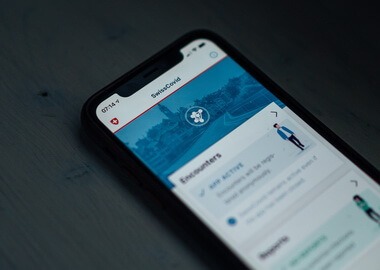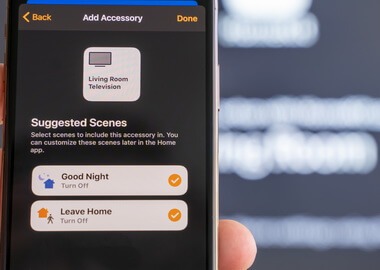Top Mobile App Categories during COVID-19
What is it they say, where one door shuts, another opens? The pandemic has certainly shut many doors for many people. But it has also brought some opportunities in disguise.
Just look at the spike in mobile app usage in COVID-19. Diet and weight loss apps alone saw a whopping 1,294% increase in download in 2020 compared to 2019. And this is one example of many. Some surges in the mobile app market were obvious. Others, not so much.
Let’s go through the mobile app categories that take it all during COVID-19 and will likely stay with us after the pandemic is, hopefully, no more.
It’s curious how things played out with COVID-19 and the mobile app industry trends. From the very first days of pandemic-induced changes — stay-at-home orders, massive shift to home-office and homeschooling — many mobile apps became not only useful but critical.
Here’s what Statista shows about the growth of certain categories of mobile apps in the first month of the pandemic.
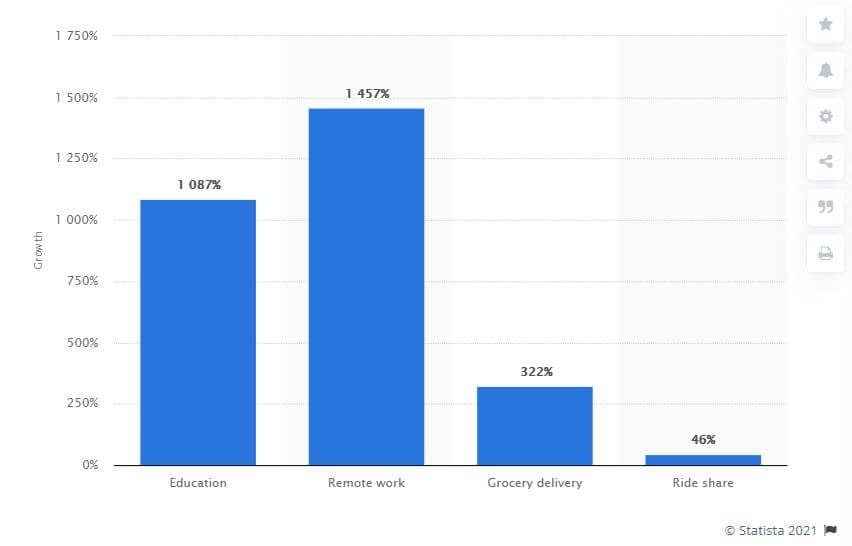
Increase in downloads of COVID-19 impacted apps in the United States. Image credit: Statista
Together with web platforms that we use daily to work, study and regularly restock food supplies, mobile apps helped us adapt to the new lifestyle amid the pandemic.
Communication
If you ask which apps benefited most from COVID-19, messengers and video chats would probably be the first that come to mind. Fast Company reported that Zoom was the 4th most downloaded app in 2020, referring to App Annie’s chart. Google Meet effortlessly made the Top-10 list which is not surprising given the increased demand for enterprise-level conferencing solutions.
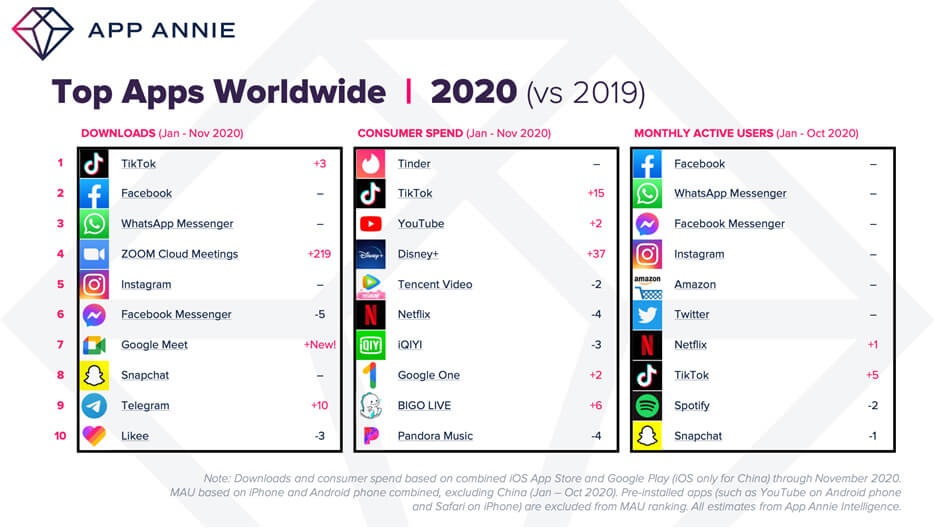
Top Apps Worldwide 2020. Image credit: App Annie
Interestingly, it’s unlikely that the demand for quality video conferencing tools will go down after the pandemic. Studies increasingly show that even after the offices are reopened, more than half of employees want to have an opportunity to work remotely, at least in part. There are a lot of talks about the hybrid workforce model that will not only help companies save more and attract much-needed talent but also become more resilient, sustainable and agile in the new norm.
Contact Digiteum
Order and delivery
If there’s one category of mobile apps that really made our lives easier in 2020, it would be food order and delivery. Not that we would starve. But things were hectic and people experienced an incredible lack of time trying to work, homeschool and manage everything in very unusual settings. Food order and delivery apps like Uber Eats or Deliveroo were saviors for many households.
There’s another side of this story though. On-demand meal delivery applications helped many small and medium restaurants stay in business and keep the staff during the most trying times. Some local restaurant owners admit that on-demand apps helped them stay afloat. Despite controversies around capped commissions, hefty losses and work conditions for delivery couriers in this niche, the third-party delivery model is said to gain momentum in 2021 and beyond.
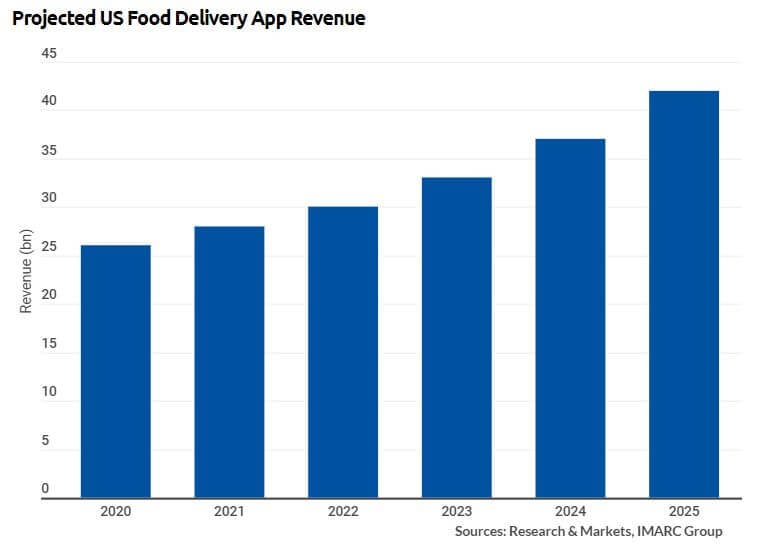
Projected U.S. Food Delivery App Revenue. Image credit: Business of Apps
Mobile shopping
Mobile shopping became one of the top mobile apps categories during COVID-19 for obvious reasons. C19 made offline shopping difficult, at times impossible, uncomfortable and even frightening for some people.
To be sure, even before the pandemic, the brick-and-mortar model was already on the edge in such sectors as electronics and household goods. Quarantine and social distancing measures caused the surge in adoption of online shopping across these and, basically, any other sector in the industry, from groceries to home improvement supplies.
Web platforms are responsible for the majority of online shopping, but mobile applications get their share. App by Amazon, one of the biggest retailers of all time, earned a precious place among the top 10 apps Americans couldn’t live without in 2020 along with Google Maps, Chrome and social media apps.
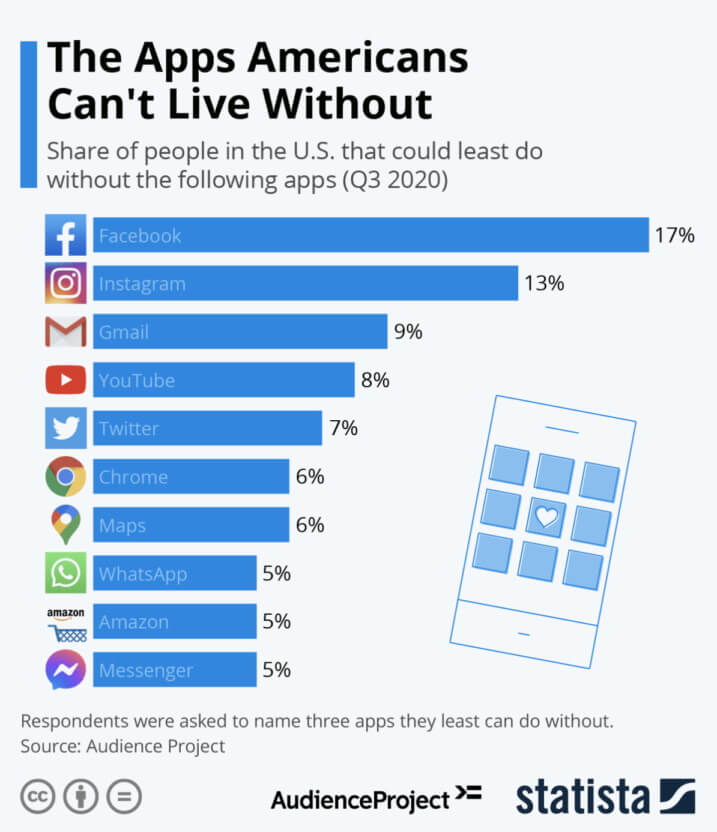
The Apps Americans Can’t Live Without. Image credit: Statista
Studies show that people who once adopted online shopping are willing to stick to the new habits.
mHealth
Some of the most critical mobile applications in COVID-19 period were and are healthcare apps. mHealth came to rescue when doctors were swamped, hospitals were full and it didn’t feel safe to visit any medical institution.
Chronic patients were hit the most as they had to deal with interrupted or delayed treatment. To prevent this from happening, both doctors and patients started looking into mobile applications for patient engagement, treatment monitoring, scheduling, virtual consulting, etc. Downloads of apps for managing diabetes, for example, leaped by 482% in 2020. Entire hospitals updated their fleets of apps and now promote their mobile tools for convenient and safe healthcare services.
Education
Global eLearning market was booming even before the pandemic. The events of 2020 only escalated the demand. Educational platforms and mobile apps made a difference when schools were closed, then reopened, then closed again, then reopened for half-weeks, then for half-days — you see, it was and still is complicated.
Unfortunately, the abundant eLearning platforms and other edtech available in the market, some of them are brilliant, well-designed tools, did not solve the problem of an instant shift to homeschooling, rather patched it as much as they could in these circumstances. Teachers were reporting high log-out and absence rates for a variety of reasons — lack of broadband, device sharing between siblings, insufficient time to study.
This only proves that in spite of being crowded and diverse, edtech market is still full of opportunities and requires smart, affordable and reliable solutions for effective education.
Pandemic-related apps
This is a special category of mobile applications that could appear only in the situation we found ourselves in in 2020. First, there was a wave of COVID-19 trackers, real-time visualizations and maps, contact tracing apps that raised a lot of privacy questions.
As the pandemic is slowing down thanks to vaccination and growing natural immunity, governments and private companies are talking more about post-pandemic applications we’ll need to revive traveling and social life and ensure public safety.
Vaccine/health passports, C19 wallets with test results and similar applications are on the radar of governments, large tech companies and startups. IBM was among the first to develop a flexible multipurpose application Digital Health Pass. New York has developed an NYS Excelsior Pass Wallet to be used in the state. Based on the reviews on the App Store, there’s still a lot to work on though.
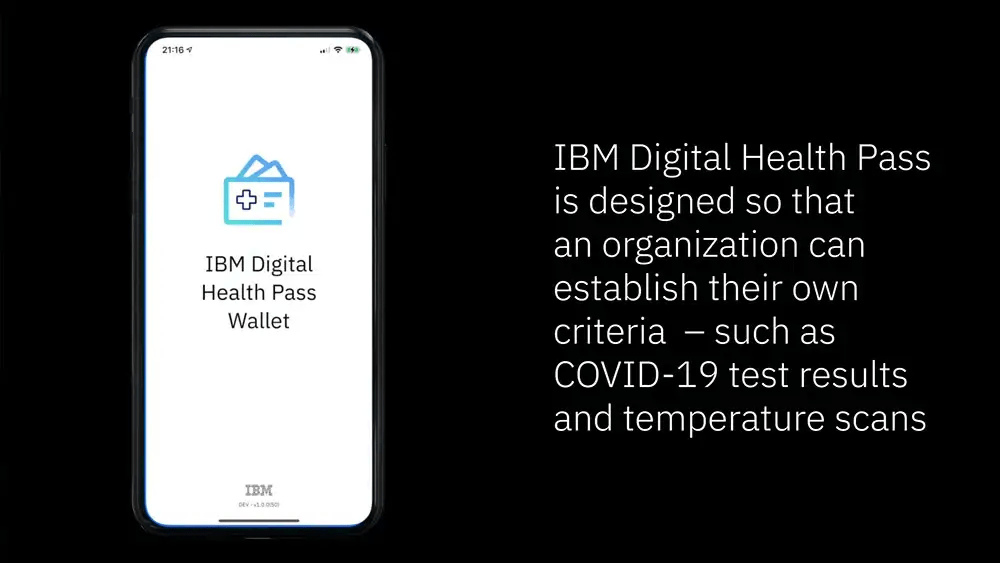
IBM Digital Health Pass. Image credit: IBM
It’s obvious why all the apps listed above were and are so hot right now. Here are the segments of the mobile app market during the COVID-19 pandemic that also saw an unusually high growth rate. Unlike the first batch, these apps don’t cross the mind at first. But their increasing popularity makes perfect sense if you take a closer look.
Smart home applications
Fun fact. 70% of consumers did any sort of renovation or remodeling due to spending more time at home, and more than half of them bought at least one smart home device, Xiaomi reported in a 2020 study. Where there is a smart device, there is a companion app to configure and manage the thing.
Apps for process automation
Mobile apps that help make business processes more efficient will always be in demand, be it automated invoice processing, supply chain management or mobile payment in banking. C19 made mobile tools like Samsara Fleet for truck drivers or a classic ABBYY FineScanner an absolute necessity.
Mental health
2020 pushed many people to their limits. Not everyone can work from home, not everyone can take isolation, and certainly, not many people can stay perfectly calm and steady facing the crisis of this scale. Digital Health Trends showed a 200% increase in mental health app download in 2020. See that distinctive dark blue line on the heatmap? This is the demand for mental health solutions in 2019-2020 according to the ORCHA study on the digital trends for 2021. It beats diabetes, pregnancy and even fitness applications.
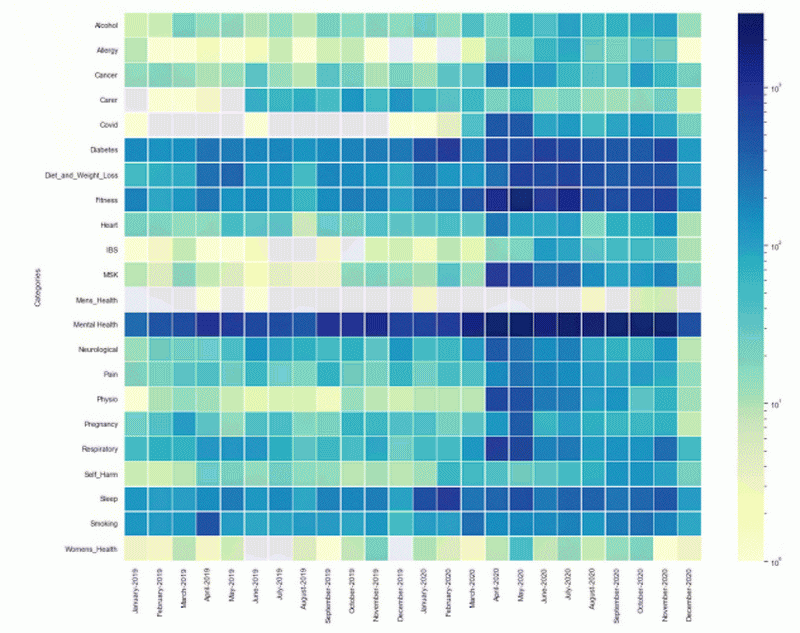
COVID-19: Digital Health Trends & Opportunities for 2021. Image credit: ORCHA
Instead of conclusion
Every once in a while, you can come across an article with a clickbait title saying that Mobile Apps Are Dying or, worse, Already Dead and dropping a hot new tech that is supposed to substitute applications.
“At the height of the pandemic, mobile usage sky-rocketed, with [App Annie] calculating that COVID-19 had accelerated normal mobile adoption by two to three years,” Computer Weekly recently said referring to App Annie 2020 research. How is that for good old apps?
In reality, the mobile application market is extremely flexible and adaptive to the changing demand and economies. Just looking at the fluctuations in top mobile app development industries during the COVID period, you can say a lot about people’s needs and priorities during this eventful year.
If you are looking into business opportunities in this market, you have chosen good timing. And if you need a skilled mobile development team, you are in the right place, too. Check our mobile app development services or drop a line to start the talk.
Contact Digiteum


